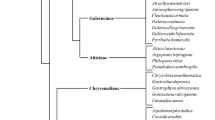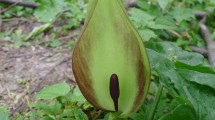Abstract
Limonoids such as deoxylimonin, obacunone and pedonin are known to have antifeedant effects against some lepidopteran pests. However, there is no electrophysiological data showing the effect these compounds have on taste receptor cells. This information gap is due to the fact that limonoids are insoluble in water and this makes it difficult to apply the tip-recording technique in an electrophysiological bioassay of limonoids. This problem was solved by dissolving the limonoids in a mixture of SO % tetrahydrof uran and 50 % aqueous NaCl. Limonoids and sucrose so dissolved were used to investigate responses of Eldana saccharina maxillary styloconic sensilla. The solvent mixture did not appear to damage the taste receptor cells and the taste receptor responses to solutes dissolved in that solvent were reproducible. Sucrose stimulated a cell in the medial as well as in the lateral styloconic sensilla. Deoxylimonin alone stimulated a cell in the medial sensillum but not in the lateral sensillum. When presented with sucrose, deoxylimonin inhibited the sugar receptor cell and this was also true for obacunone.
Résumé
Les limonoides tels que la déoxylimonine, l’obacunone et la pédonine sont connus pour leurs propriétés désappéntantes sur certains lépidoptères ravageurs. Cependant il n’existe aucune donnée électrophysiologique mettant en évidence l’effet de ces substances sur les cellules des récepteurs gustatifs. Cette lacune provient de la difficulté d’appliquer une technique d’enregistrement distal avec les limonoides, qui sont insolubles dans l’eau. Les limonoides ont donc été dissouts dans un mélange de 50% tetrahydrofurane et 50% NaCl en solution aqueuse. On a observé la réponse des sensilles maxillaires stylo-coniques aux limonoides et an sucrose ainsi préparés. Le mélange de solvants ne semble pas endommager les cellules du récepteur gustatif et al réponse aux solutés est reproductible. Le sucrose stimule une cellule du sensille stylo-conique médian ainsi que du sensille stylo-conique latéral. La déoxylimonine seule ne stimule que le sensille médian. La déoxylimonine et l’obacunone inhibe la réponse au sucrose de la cellule réceptrice du sucre.
Similar content being viewed by others
References
Alford A. R., Cullen J. A., Storch R. N. and Bentley M. D. (1987) Antifeedant activity of limonin against the Colorado potato beetle (Coleoptera Chrysomelidae). J. econ. Entomol. 80, 599.
Blaney W. M. (1975) Behavioral and electrophysiological studies of taste discrimination by the maxillary palps of larvae of Locusta migratoria (L). J. exp. Biol. 62, 555–569.
Blaney W. M. (1980) Chemoreception and food selection by locusts. Olfaction and Taste 7, 127–130.
Blaney W. M., Simmonds S. J., Ley S. V., Katz R. B. (1987) An electrophysiological and behavioral study of insect antifeedant properties of natural and synthetic drimane-related compounds. Physiol. Entomol. 12, 281–291.
Butterworth J. H. and Morgan E. D. (1968) Isolation of a substance that suppresses feeding in locusts. Chem.Comm. 23–24.
Butterworth J. H. and Morgan E. D. (1971) Investigation of the locust feeding inhibition of the seeds of the neem tree, Azadirachta indica. J. Insect Physiol. 17, 969–977.
Chapman R. F. (1974) The chemical inhibition of feeding by phytophagous insects: a review. Bull. entomol. Res. 64, 339–364.
Dethier V. G. (1972) Sensitivity of the contact chemoreceptors of the blowfly to vapours. Proc. Nat. Acad. Sei. USA 69, 2189–2192.
Dethier V. G. (1974) The specificity of the labellar chemoreceptors of the blowfly and the response to natural foods. J. Insect Physiol. 20 1859–1869.
Dethier V. G. (1980) Evolution of receptor sensitivity to secondary plant substances with special reference to deterrents. Am. Nat. 115, 45–66.
Frazier J. L. and Hanson F. E. (1986) Electrophysiological recordings and analysis of insect chemosensory responses. In Insect Plant Interactions (Edited by Miller J. R. and Miller T.A.), pp. 285–330. Springer-Verlag, N.Y.
Haskell P. T. and Schoonhoven L. M. (1969) The function of certain mouthpart receptors in relation to feeding in Schistocerca gregaria and Locusta migratoria migratorioides. Entomol. exp.appl. 12, 433–440.
Hassanali A., Bentley M. D., Ole Sitayo E. N., Njoroge P. E. W. and Yatagai M. (1986) Studies on limonoid insect antifeedants. Insect Sei. Applic. 7, 495.
Hassanali A., Bentley M. D., Alexandra M. Z. S., Williams D. J., Shepherd R. N. and Chapya A. W. (1987) Pedonin, a spiro tetranortriterpenoid insect antifeedant from Harissonia abyssinica. Phytochemistry 26, 573–575.
Hodson E. S., Lettvin J. Y. and Roeder K. D. (1955) Physiology of a primary chemoreceptor unit. Science 122, 417–418.
Ishikawa S., Hirao T. and Arai N. (1969) Chemosensory basis of hostplant selection in the silkworm. Entomol. exp. appl. 12, 544–554.
Klocke J.A. and Kubo I. (1982) Citrus limonoids by-products as insect control agents. Entomol. exp. appl. 32, 299–301.
Kraus N., Cramer R., Bökel M., and Sawitzk G. (1981) New insect antifeedants from Azadirachta indica and Melia azadirachta. Proc. 1st Neem Conf. Rottach-Egem, W. Germany June 1980. pp. 267–277.
Ma W.C. (1972) Dynamics of feeding responses in Pieris brassicae Linn, as a function of chemosensory input: a behavioral, ultrastructural and electrophysiological study. Meded. Landbouwhogesch. Wageningen 72/11, pp.162.
Ma W. C. (1977) Alteration of chemoreceptor function in armyworm larvae (Spodoptera exempta) by a plant-derived sesquiterpenoid and sulfhydryl reagent. Physiol. Entomol. 2, 199–207.
Morita H. and Takeda K. (1959) Initiation of spike potentials in contact chemosensory hairs of insects II. The effect of electrical current on tarsal chemosensory hairs of Vanessa. J. Cell Comp. Physiol. 54, 177–187.
Saxena R. C., Justo H. D. and Epino P. B. (1984) Evaluation and utilization of neem cake against the rice brown planthopper, Nilaparvata lugens (Homoptera: Delphacidae). J. econ. Entomol. 77, 502–507.
Schneider D. (1957) Electrophysiologiche Unterschugen von Chemo und mecharnorezeptoren der antenne des Seidenspinners, Bombyx mori L. Z. Vergl. Physiol. 40, 8–14.
Schoonhoven L. M. (1973) Plant recognition by lepidopterous larvae. Symp. R. Entomol. Soc. London 6, 87–99.
Schoonhoven L. M. (1982) Biological aspects of antifeedants. Ent. exp. appl. 31, 57–69.
Schoonven L. M. and Dethier V. G. (1966) Sensory aspects of host plant discrimination by lepidopterous larvae. Arch. Neerl. Zool. 16, 497–530.
Staedler E. (1976) Sensory aspects of insect plant interactions. Proc. XV Int. Congr. Ent., Washington D.C. 1976, pp. 228–243.
Sturkow B. (1959) Ueber den Deschmackssinn und den Tastsinn von Leptinotarsa decemlineata Say (Chrysomelidae). Z. ver gl. Physiol. 42, 255–302.
Author information
Authors and Affiliations
Rights and permissions
About this article
Cite this article
Waladde, S.M., Hassanali, A. & Ochieng, S.A. Taste Sensilla Responses to Limonoids, Natural Insect Antifeedants. Int J Trop Insect Sci 10, 301–308 (1989). https://doi.org/10.1017/S1742758400003532
Received:
Revised:
Published:
Issue Date:
DOI: https://doi.org/10.1017/S1742758400003532




